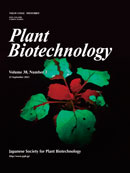38 巻, 3 号
選択された号の論文の14件中1~14を表示しています
- |<
- <
- 1
- >
- >|
Review
Invited Paper
-
2021 年 38 巻 3 号 p. 285-295
発行日: 2021/09/25
公開日: 2021/09/25
[早期公開] 公開日: 2021/09/18PDF形式でダウンロード (1584K) -
2021 年 38 巻 3 号 p. 297-304
発行日: 2021/09/25
公開日: 2021/09/25
[早期公開] 公開日: 2021/09/18PDF形式でダウンロード (2838K)
Original Papers
-
2021 年 38 巻 3 号 p. 305-310
発行日: 2021/09/25
公開日: 2021/09/25
[早期公開] 公開日: 2021/06/24PDF形式でダウンロード (1886K) -
2021 年 38 巻 3 号 p. 311-315
発行日: 2021/09/25
公開日: 2021/09/25
[早期公開] 公開日: 2021/09/18PDF形式でダウンロード (2854K) -
2021 年 38 巻 3 号 p. 317-322
発行日: 2021/09/25
公開日: 2021/09/25
[早期公開] 公開日: 2021/09/18PDF形式でダウンロード (3265K) -
2021 年 38 巻 3 号 p. 323-330
発行日: 2021/09/25
公開日: 2021/09/25
[早期公開] 公開日: 2021/09/18PDF形式でダウンロード (3295K) -
2021 年 38 巻 3 号 p. 331-337
発行日: 2021/09/25
公開日: 2021/09/25
[早期公開] 公開日: 2021/09/18PDF形式でダウンロード (1119K) -
2021 年 38 巻 3 号 p. 339-344
発行日: 2021/09/25
公開日: 2021/09/25
[早期公開] 公開日: 2021/09/18PDF形式でダウンロード (706K) -
2021 年 38 巻 3 号 p. 345-353
発行日: 2021/09/25
公開日: 2021/09/25
[早期公開] 公開日: 2021/09/18PDF形式でダウンロード (4135K) -
2021 年 38 巻 3 号 p. 355-366
発行日: 2021/09/25
公開日: 2021/09/25
[早期公開] 公開日: 2021/09/18PDF形式でダウンロード (31105K)
Short Communications
-
2021 年 38 巻 3 号 p. 367-371
発行日: 2021/09/25
公開日: 2021/09/25
[早期公開] 公開日: 2021/09/18PDF形式でダウンロード (928K) -
2021 年 38 巻 3 号 p. 373-378
発行日: 2021/09/25
公開日: 2021/09/25
[早期公開] 公開日: 2021/09/18PDF形式でダウンロード (1143K)
Notes
-
2021 年 38 巻 3 号 p. 379-386
発行日: 2021/09/25
公開日: 2021/09/25
[早期公開] 公開日: 2021/09/18PDF形式でダウンロード (4084K) -
2021 年 38 巻 3 号 p. 387-390
発行日: 2021/09/25
公開日: 2021/09/25
[早期公開] 公開日: 2021/09/18PDF形式でダウンロード (2610K)
- |<
- <
- 1
- >
- >|
